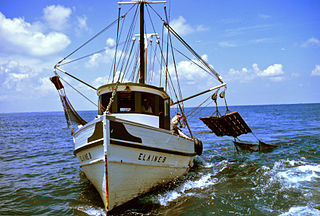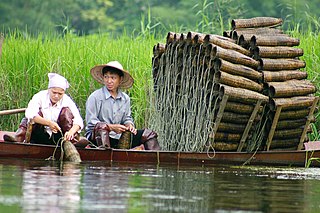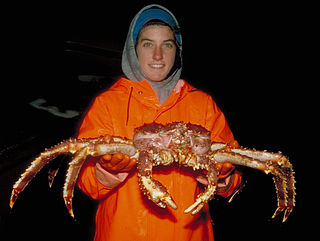
A corf (pl. corves) also spelt corve (pl. corves) is a container of wood, net, chicken wire, metal or plastic used to contain live fish, eels or crustaceans (such as crayfish) underwater, at docks or in fishing boats. [1] [2]

A corf (pl. corves) also spelt corve (pl. corves) is a container of wood, net, chicken wire, metal or plastic used to contain live fish, eels or crustaceans (such as crayfish) underwater, at docks or in fishing boats. [1] [2]
1350–1400; Middle English from Dutch and German Korb, ultimately borrowed from Latin corbis basket; [3] cf. corbeil
Corves were originally crucial to keep captured fish fresh until the boat with the catch reached its harbor. [4] A corf could be towed behind the boat while fishermen made the journey from the fishing grounds to the fish market. These journeys could last up to half a day. [5] When used for storing eels in Blekinge, Sweden, the corves could be as large as 3.75 by 1.33 by 0.8 m (12 ft 3+5⁄8 in by 4 ft 4+3⁄8 in by 2 ft 7+1⁄2 in) and contain about 2 metric tons (2.2 short tons; 2.0 long tons) of eels. They would be anchored approximately 100 m (330 ft) from land in an area where the water circulation was good to keep the eels alive. [6] Smaller corves were often used in fishing boats to keep live bait for longline fishing. [4]
The corf could also be built into the boat, and sometimes be a significant part of it. [4] Fishing boats with a well amidships where water is circulated through small holes in the hull are known as well smacks. [7] [8]
In present days corves used for this purpose have commonly been replaced by refrigeration and freezing. [9]
A corf-house is a small building or shed constructed for commercial curing of fish, mostly salmon, in. It is also used to store nets and fishing equipment in. [3] One such house is the listed By Lovat Bridge Corf House in Beauly, Scotland. [10]
Corves are mainly used by recreational fishermen and mass-produced in plastic netting or metal. [11] [12] Their use is regulated through laws and regulations in some countries such as Sweden, [13] [14] [15] and Australia. [16]
Modern fishing boats often have integral corves. These are built into the boat and the water in them kept fresh and oxygenated through a circulatory system with water and air pumps. This kind of corf is called a livewell. [17] [18]

Spearfishing is fishing using handheld elongated, sharp-pointed tools such as a spear, gig, or harpoon, to impaling the fish in the body. It was one of the earliest fishing techniques used by mankind, and has been deployed in artisanal fishing throughout the world for millennia. Early civilizations were familiar with the custom of spearing fish from rivers and streams using sharpened sticks.

Fishery can mean either the enterprise of raising or harvesting fish and other aquatic life or, more commonly, the site where such enterprise takes place. Commercial fisheries include wild fisheries and fish farms, both in freshwater waterbodies and the oceans. About 500 million people worldwide are economically dependent on fisheries. 171 million tonnes of fish were produced in 2016, but overfishing is an increasing problem, causing declines in some populations.

The fishing industry includes any industry or activity that takes, cultures, processes, preserves, stores, transports, markets or sells fish or fish products. It is defined by the Food and Agriculture Organization as including recreational, subsistence and commercial fishing, as well as the related harvesting, processing, and marketing sectors. The commercial activity is aimed at the delivery of fish and other seafood products for human consumption or as input factors in other industrial processes. The livelihood of over 500 million people in developing countries depends directly or indirectly on fisheries and aquaculture.

The yellowfin tuna is a species of tuna found in pelagic waters of tropical and subtropical oceans worldwide.

Commercial fishing is the activity of catching fish and other seafood for commercial profit, mostly from wild fisheries. It provides a large quantity of food to many countries around the world, but those who practice it as an industry must often pursue fish far into the ocean under adverse conditions. Large-scale commercial fishing is called industrial fishing.

A well smack was a type of traditional fishing boat in use in the United Kingdom and then the Faroe Islands between the late 18th century and around 1920. It had a well amidships. The well was filled with circulated external water, which kept fish alive until delivered to land and sold. It was a modified form of a fishing smack.

A fish trap is a trap used for catching fish and other aquatic animals of value. Fish traps include fishing weirs, cage traps, fish wheels and some fishing net rigs such as fyke nets.

Artisanal fishing consists of various small-scale, low-technology, low-capital, fishing practices undertaken by individual fishing households. Many of these households are of coastal or island ethnic groups. These households make short fishing trips close to the shore. Their produce is usually not processed and is mainly for local consumption. Artisan fishing uses traditional fishing techniques such as rod and tackle, fishing arrows and harpoons, cast nets, and small traditional fishing boats. For that reason, socio-economic status of artisanal fishing community has become an interest of the authorities in recent years.

Alaskan king crab fishing is carried out during the fall in the waters off the coast of Alaska and the Aleutian Islands. The commercial catch is shipped worldwide. Large numbers of king crab are also caught in Russian and international waters.

A fishing vessel is a boat or ship used to catch fish and other valuable nektonic aquatic animals in the sea, lake or river. Humans have used different kinds of surface vessels in commercial, artisanal and recreational fishing.

Fishing is a prehistoric practice dating back at least 70,000 years. Since the 16th century, fishing vessels have been able to cross oceans in pursuit of fish, and since the 19th century it has been possible to use larger vessels and in some cases process the fish on board. Fish are normally caught in the wild. Techniques for catching fish include hand gathering, spearing, netting, angling and trapping.
This page is a list of fishing topics.
The following outline is provided as an overview of and topical guide to fishing:

China has one-fifth of the world's population and accounts for one-third of the world's reported fish production as well as two-thirds of the world's reported aquaculture production. It is also a major importer of seafood and the country's seafood market is estimated to grow to a market size worth US$53.5 Billion by 2027.

Eels are ray-finned fish belonging to the order Anguilliformes, which consists of eight suborders, 20 families, 164 genera, and about 1000 species. Eels undergo considerable development from the early larval stage to the eventual adult stage and are usually predators.

A livewell is a water tank found on many fishing boats that is used to keep bait and caught fish alive. It works by pumping fresh water from the surrounding body into the tank, as well as keeping the water aerated. A rule of thumb for determining the necessitated size of a livewell is that every one inch length of fish needs a gallon of water if it is desired to keep the fish alive for a prolonged period of time.

The River Corve is a minor river in Shropshire, England. It is a tributary of the River Teme which it joins in the town of Ludlow, and which joins the River Severn at Powick near Worcester. The valley it flows through is known as the Corvedale, a term used as a general name for the area, and a name used for example by the primary school in Diddlebury. It is sometimes (archaically) spelled "Corf", which is its pronunciation.

Fishing is important to the national economy of Vanuatu. It is the main source of income for many in the islands and Vanuatu's biggest export. According to 2009 figures, approximately 77% of households in Vanuatu are involved in fishing activity. According to 2005 figures, Vanuatu caught 151,080 fish in that year, with frozen fish accounted for half of Vanuatu's commodity exports.

The fishing industry in Denmark operates around the coastline, from western Jutland to Bornholm. While the overall contribution of the fisheries sector to the country's economy is only about 0.5 percent, Denmark is ranked fifth in the world in exports of fish and fish products. Approximately 20,000 Danish people are employed in fishing, aquaculture, and related industries.

A fishing license (US), fishing licence (UK), or fishing permit is an administrative or legal mechanism employed by state and local governments to regulate fishing activities within their administrative areas. Licensing is one type of fisheries management commonly used in Western countries, and may be required for either commercial or recreational fishing.